 Les Woolliscroft, Reader in the Department of Automatic Control
and Systems Engineering at the University of Sheffield, died on
12 March 1996, aged 51.
Les Woolliscroft, Reader in the Department of Automatic Control
and Systems Engineering at the University of Sheffield, died on
12 March 1996, aged 51.
 Les Woolliscroft, Reader in the Department of Automatic Control
and Systems Engineering at the University of Sheffield, died on
12 March 1996, aged 51.
Les Woolliscroft, Reader in the Department of Automatic Control
and Systems Engineering at the University of Sheffield, died on
12 March 1996, aged 51.
Following a period as research associate in the Mullard Space Science Laboratory, University College, London, Les joined the Space Physics Group at the University of Sheffield in 1972. He was responsible for directing a number of highly successful rocket campaigns in northern Scandinavia. This involved considerable planning as well as the design and production of the Sheffield group's instruments. The results from one of these rocket campaigns were one of the (then) SRC's scientific "highlights". During this period he also voluntarily undertook a teaching role in the Department of Physics as well as becoming an Open University tutor. He was much in demand by clubs and societies to give talks on astronomy.
His research reputation grew rapidly, involving highly interdisciplinary collaboration between control, computer science and electronic engineering on the one hand and applied mathematics and physics on the other. Working at these interfaces won him great respect and many friends. In 1989 he made the transition from full-time researcher to a combined research and teaching post as Lecturer in the Department of Automatic Control and Systems Engineering where he became Senior Lecturer and then Reader in 1991. His natural enthusiasm and willingness to contribute his time and ideas both to students and to staff were a wonderful asset. He had the knack of leading students (and colleagues) to work things out for themselves and it was only later, on reflection, that you realised that you had been gently guided towards the conclusion. Les was Principal Investigator of the Digital Wave Processing (DWP) Experiment on one of the ESA/NASA cornerstone missions, CLUSTER. There, his contribution was not only in providing an instrument which is at the heart of the Wave Consortium, but in the planning of the data handling and science analysis facilities to ensure the maximum exploitation of the mission products. His vision led him to be always aware of the possibilities of future missions, and the projects he set his students enabled him to enter early discussions with at least some preliminary study.
Prior to this he had been the Principal Investigator and Project Engineer for the Plasma Wave Experiment on the AMPTE UKS spacecraft. This instrument has yielded a considerable amount of data on the processes in the outer magnetosphere, solar wind and in the interaction between natural and release plasmas. In 1986 he was awarded the NASA Group Achievement Award for this work and also an award from BMFT, the West German Ministry for Research and Technology. More recently he was involved in contributing to instruments for many scientific space missions including Mars '96 as PI of the Elisma DWP instrument; Cassini as a Co-I in the RPWS team; and Rosetta as Co-I in the Modulus and Midas teams.
During his many overseas commitments Les was a wonderful companion - his enthusiasm in getting to know the culture of the places he visited was infectious. His eagerness for sampling exotic dishes was well matched by his skill at cooking. Tributes to Les have come from all parts of the world: Les was "...an inspirational friend, teacher and mentor", "a man of integrity", "a fine team leader", "softly spoken with a commanding presence". We all valued his wisdom. He is a great loss to the Sheffield University, to the wider academic community, the international space community and to a great many of us personally. His wife, Shelagh, and his children, Kate, Mike and Tim have our every sympathy.
SB/PJF/RFH/PO/HA (contributed by Hugo Alleyne, April 1996)